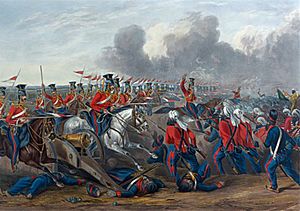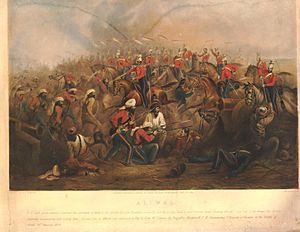Battle of Aliwal facts for kids
Quick facts for kids Battle of Aliwal |
|||||||
|---|---|---|---|---|---|---|---|
| Part of the First Anglo-Sikh War | |||||||
 Charge of the British 16th Lancers against Sikh Fauj-i-Ain infantry and artillery. |
|||||||
|
|||||||
| Belligerents | |||||||
| Commanders and leaders | |||||||
| Sir Harry Smith | Sardar Ranjodh Singh Majithia | ||||||
| Strength | |||||||
| 12,000 30–32 guns |
20,000 69–70 guns |
||||||
| Casualties and losses | |||||||
| 850 | 2,000 67 guns |
||||||
The Battle of Aliwal was a major fight that happened on January 28, 1846. It was part of the First Anglo-Sikh War. This battle took place in northern India, in a region now known as Punjab, India.
The battle was fought between the British forces and the Sikh army. Sir Harry Smith led the British troops. The Sikh forces were commanded by Ranjodh Singh Majithia. The British won this battle. Many people believe this victory was a turning point in the war.
Contents
Why the Battle Happened
The First Anglo-Sikh War started about six years after the death of Ranjit Singh. He was a powerful leader who had built the Sikh Empire in the Punjab. After he died, the Punjab region became very unstable and disorganized.
At the same time, the British were increasing their military strength near the Punjab border. Eventually, the Sikh Khalsa Army, which was becoming very restless, crossed the Sutlej River. They invaded British territory. Their own leaders, who didn't fully trust their soldiers, pushed them to do this.
In December 1845, the British East India Company army fought a very tough battle called the Battle of Ferozeshah. The Sikh armies, led by Lal Singh and Tej Singh, eventually retreated. However, the British army had suffered heavy losses. They didn't start fighting again for several weeks.
The Sikhs were also discouraged by their commanders' retreats. But they soon received more troops who hadn't fought yet. These new forces crossed the Sutlej River again. They set up a strong position at Sobraon. Meanwhile, a group of Sikh soldiers, about 7,000 men with 20 guns, crossed the river further up. This group was led by Ranjodh Singh Majithia. Their goal was to attack the British fort at Ludhiana and threaten the British supply lines.
To deal with this threat, the British commanders sent a special group of soldiers. This group was led by Sir Harry Smith. Their mission was to clear out the Sikh forces in their rear.
The Journey to Battle
On January 16, 1846, Sir Harry Smith's troops recaptured two areas. These were Fategarh and Dharmkot, which the Sikhs had taken. Ranjodh Singh's cavalry, which were irregular troops, had raided many areas. They even set fire to parts of the British camp at Ludhiana. But his main army was moving very slowly towards Ludhiana.
Harry Smith first planned to attack Ranjodh Singh's army at Buddowal. However, he learned how strong the Sikh forces were. He also received new orders from his commander, Gough. So, he changed his plan. Smith quickly marched his troops through Jagraon, picking up another British regiment there. His goal was to reach Ludhiana before the main Sikh army.
On January 21, as he left Buddowal, Sikh cavalry kept attacking his rear guard. They managed to capture most of Smith's baggage animals, like mules and elephants. They also attacked any soldiers who fell behind. Despite these attacks, Smith successfully reached Ludhiana. His troops were very tired. A group of soldiers from Delhi, including two Gurkha battalions, joined him there.
After his troops rested, Smith advanced again towards Buddowal. The Sikhs had moved back to Aliwal near the Sutlej River. They were waiting for more soldiers to join them. On January 28, Smith began to advance against them, moving carefully at first.
The Battle of Aliwal
The Sikhs had set up their position along a ridge. This ridge was about 4 miles (6.4 km) long. It stretched between the villages of Aliwal and Bhundri. The Sutlej River was very close behind their entire line. This made it hard for them to move around. It also meant a retreat could be very dangerous.
After the first shots from the cannons, Smith realized that Aliwal was the weakest point in the Sikh line. He sent two of his four infantry brigades to capture the village. From there, they could fire along the Sikh center, hitting many soldiers at once. The British soldiers took the village. Then, they started pushing forward to threaten the river crossings.
As the Sikhs tried to move their left side back, some of their cavalry became a danger to the open British left side. A British and Indian cavalry group, led by the 16th Lancers, charged. They scattered the Sikh cavalry. The 16th Lancers then attacked a large group of Sikh infantry. These were soldiers who had been trained in the European style by a mercenary from Naples. They formed a square shape to create a strong defense against cavalry. Even so, the 16th Lancers broke through their square. Both sides lost many soldiers.
The Sikh infantry in the middle tried to defend a dry stream bed. But they were hit by fire from the side and forced out into the open. Then, they were attacked by British cannons.
Unlike many other battles in the Anglo-Sikh Wars, the Sikh retreat at Aliwal quickly turned into a complete and messy escape. As the Sikh soldiers ran across the river crossings, they left behind most of their cannons. These were either on the river bank or in the water. They also abandoned all their bags, tents, and supplies. The Sikhs lost about 2,000 men and 67 cannons.
What Happened After
After the battle, Smith wrote:
I have gained one of the most glorious battles ever fought in India ... Never was victory more complete, and never was one fought under more happy circumstances, literally with the pomp of a field day; and right well did all behave.
Many people called Smith's victory the "Battle without a mistake." Except for the 16th Lancers, who lost 144 out of about 300 men, most of Smith's units did not have many casualties.
Armies in the Battle
Here are some of the main military units that fought in the Battle of Aliwal:
British Regiments
- 16th The Queen's Lancers
- 31st Foot
- 50th Foot
- 53rd Foot
Indian Regiments
- Governor General’s Bodyguard
- 1st Bengal Native Cavalry
- 3rd Bengal Native Cavalry
- 5th Bengal Native Cavalry
- 4th Irregular Cavalry
- Shekawati Cavalry
- 3 Batteries of Horse Artillery (cannons pulled by horses)
- 2 Field Batteries of Artillery (cannons used in the field)
- 24th Bengal Native Infantry
- 36th Bengal Native Infantry
- 47th Bengal Native Infantry
- 48th Bengal Native Infantry
- Nasiri Gurkha Battalion
- Sirmoor Gurkha Battalion



